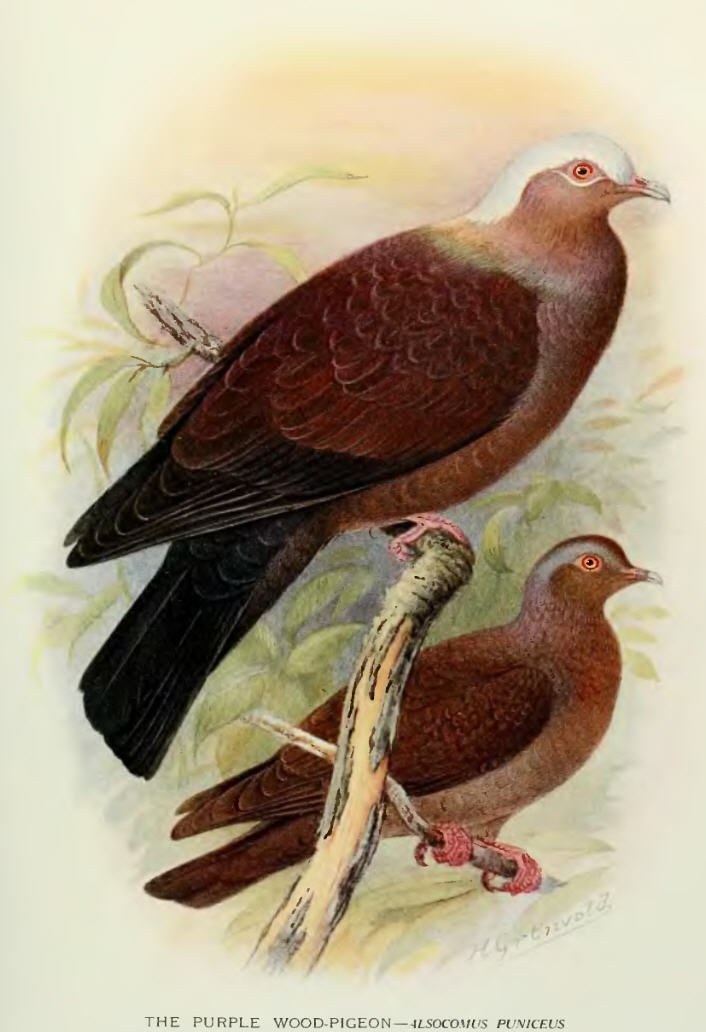| Citation |
|
Description |
Geographic Range [top]
Range Description: Columba punicea is locally distributed across its broad range, which encompasses parts of northern India, Bangladesh, Myanmar, Thailand, Laos, Cambodia and Vietnam (BirdLife International 2001). It appears to have been locally abundant in the early 20th century, but has declined markedly in many areas. Scattered recent records indicate that it now only occurs rarely and erratically throughout its range, although a roosting flock of 174 individuals was recorded at Don Mamuang, Thailand in 2002 (D. Wilson in litt. 2002). There are no recent records from China, where it was previously recorded on Hainan Island and in south-east Tibet, and it has occurred as a vagrant in Peninsular Malaysia. In Vietnam it is very rare and local with small numbers recently reported from mangrove forest at Mang Den/Kon Plong, Kontum Province in 2010 and near Ho Tram, approx 100 km south-east of Ho Chi Minh City, in 2011 (R. Craik in litt. 2012). However, large flocks were reported in the past from near Da Lat (C. Robson in litt. 2012) and it is regarded as uncommon but resident on some islands in Bai Tu Lam Bay (S. Mahood in litt. 2012). In India, it is a rare resident in Orissa and northeast India, with most recent records from the Similipal hills. Here birds have been encountered throughout the year with the highest count involving a flock of 17 birds in the Upper Barakamura range (M. Nair in litt. 2012).
Countries occurrence:
Native:
Bangladesh; Cambodia; India; Lao Peoples Democratic Republic; Malaysia; Myanmar; Sri Lanka; Thailand; Viet Nam
Possibly extinct:
China
Continuing decline in area of occupancy (AOO): Unknown
Extreme fluctuations in area of occupancy (AOO): No
Estimated extent of occurrence (EOO) - km2: 208000
Continuing decline in extent of occurrence (EOO): Unknown
Extreme fluctuations in extent of occurrence (EOO): No
Number of Locations: 11-100
Continuing decline in number of locations: Unknown
Extreme fluctuations in the number of locations: No
Upper elevation limit (metres): 1600
Range Map: Click here to open the map viewer and explore range.
Population [top]
Population: The population is estimated to number fewer than 10,000 individuals by BirdLife International (2001), based on available records and surveys. It is placed in the band 2,500-9,999 mature individuals, equating to 3,750-14,999 individuals, rounded here to 3,500-15,000 individuals.
Trend Justification: Although this speciess population trends are poorly known, it is suspected to be declining at a moderate rate, owing to the on-going conversion of habitat.
Current Population Trend: Decreasing
Additional data:
?Number of mature individuals: 2500-9999 ?Continuing decline of mature individuals: Yes
?Extreme fluctuations: No ?Population severely fragmented: No
?No. of subpopulations: 2-100 ?Continuing decline in subpopulations: Unknown
?Extreme fluctuations in subpopulations: No ?All individuals in one subpopulation: No
?No. of individuals in largest subpopulation: 1-89
Habitat and Ecology [top]
Habitat and Ecology: It frequents a wide variety of habitats from the lowlands up to 1,600 m, chiefly primary or secondary evergreen forest, but also open, deciduous dipterocarp forest, bamboo, and agricultural fields, particularly in close proximity to forest. Recent records from deciduous dipterocarp forest in Cambodia indicate an association with riverine corridors of bamboo forest (J. Bird in litt. 2007). Some records also originate from small forested islands and other coastal habitats. It is mainly frugivorous, although seeds and grain form important dietary components in some areas. Its breeding range and seasonal movements are poorly understood, but in places it appears to be semi-nomadic, perhaps in response to food availability.
Systems: Terrestrial
Continuing decline in area, extent and/or quality of habitat: Unknown
Generation Length (years): 5.6
Movement patterns: Not a Migrant
Threats [top]
Major Threat(s): Its decline is poorly understood but is suspected to be the result of hunting and habitat loss and fragmentation owing to commercial logging, small-scale timber collection, and clearance of forests for plantation agriculture, cash-crops, charcoal production and shifting cultivation.
Conservation Actions [top]
Conservation Actions: Conservation Actions Underway
Although it has been recorded from numerous protected areas, their contribution to its conservation is not known, especially given its seasonal and nomadic movements. Indeed, site-based conservation strategies are unlikely to be successful unless populations are able to follow seasonal patterns of fruit-ripening within secure protected sites.
Conservation Actions Proposed
Conduct further surveys, particularly in Myanmar, to clarify its current distribution, seasonal movements and population status. Conduct research into its ecological requirements and the relative effects of various threats operating across its range. Identify and protect, where appropriate, sites supporting key populations. Promote improved management and establish/increase buffer zones around protected areas supporting key populations. Enforce strict hunting controls within all protected areas and devise awareness campaigns to reduce pigeon hunting wherever this is possible.
Citation: BirdLife International. 2012. Columba punicea. The IUCN Red List of Threatened Species 2012: e.T22690191A37960071. http://dx.doi.org/10.2305/IUCN.UK.2012-1.RLTS.T22690191A37960071.en. Downloaded on 05 April 2016.
Disclaimer: To make use of this information, please check the .
Feedback: If you see any errors or have any questions or suggestions on what is shown on this page, please provide us with feedback so that we can correct or extend the information provided
|

